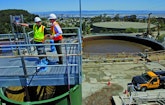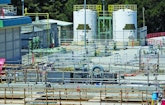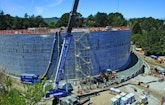
Interested in Infrastructure?
Get Infrastructure articles, news and videos right in your inbox! Sign up now.
Infrastructure + Get AlertsThe earthquake hit at 5:04 p.m. on Oct. 17, 1989. Sixty-three lives were lost. Injuries numbered in the thousands. Property loss was estimated at $6 billion. San Francisco and adjoining communities suffered severe damage to their infrastructure. The loss of pressurized water stymied firefighters, and more than a few blazes went unfought.
The San Francisco Public Utilities Commission responded by crafting their Water System Improvement Project. Enacted in 2004 and now 80 percent complete, it promises to reduce the impact of future seismic events. WSIP celebrates its 10th anniversary this year, and the results to date are nothing less than world-class.
WSIP ranks as the most expensive and complex municipal water improvement program ever in the U.S. With a price tag of $4.6 billion, WSIP promised much and was enthusiastically supported by ratepayers. Did it deliver on its ambitious promises? So far, so good, but the real test is yet to come.
The WSIP
WSIP is funded by a $4.6 billion bond measure passed by San Francisco voters in 2002. On the heels of the Loma Prieta quake, infrastructure damage was still fresh in the collective public mind. Further, USGS had assessed the 30-year chance of recurrence at 63 percent.
“Loma Prieta wasn’t so much a ‘wake-up call’ since the Great Quake of 1906 had already taught us many lessons. Like how we can leverage a tragedy like this to take advantage of public awareness, and where our main system weaknesses were,” says SFPUC General Manager Harlan Kelly Jr.
“1989 was a time of much greater reliance on infrastructure, higher population, better engineering and an economy that could finance visionary solutions. Plus, we had near-unanimous support from the ratepayers. That’s why WSIP happened when it did.”
Although SFPUC realized improvements were needed long before Loma Prieta, lack of technical solutions, budget restrictions, coordination with their wholesalers and other stakeholders, and reorganization of SFPUC itself delayed the formal implementation of the WSIP until its official start date in 2004.
The WSIP lists these five goals:
- Improve the system to provide high-quality water that reliably meets all current and foreseeable local, state and federal requirements.
- Reduce vulnerability of the water system to damage from earthquakes.
- Increase system reliability for water delivery by providing the redundancy needed to circumvent outages.
- Provide improvements related to water supply and drought protection.
- Enhance sustainability through improvements that optimize protection of the natural and human environment.
Their fourth goal is increasingly attractive throughout the drought-ridden West. SFPUC has extensive resources on their website promoting rain gardens, rainwater harvesting, low-water-use fixtures, graywater irrigation and water-efficient landscaping methods. Their popular mantra has been: Water conserved = water delivered to the system.
As of July 2014, their reservoir system was at 65 percent of its 117-billion-gallon capacity. There wasn’t much snowmelt this season, but given the long-term drought in much of the West, 65 percent sits well with SFPUC. Still, planning prudently, in January of this year customers were asked to voluntarily reduce their consumption by 10 percent. To date, that has saved 1.4 billion gallons.
When SFPUC enjoys excess delivery from the system, that water is pumped into boreholes to recharge the aquifer for emergencies or extended drought. And underground storage suffers no evaporation losses. SFPUC doesn’t draw on groundwater itself, though its customers downstream do. Kelly says SFPUC enjoys a “huge above-ground storage capacity.”
But it’s the second and third goals that form the basis of SFPUC’s most innovative (and complex) projects. “As you may know, major seismic events attract engineers from all over the world,” Kelly says. “They come to analyze the failures and learn how to avoid them. And that, of course, drives building codes. It also grows the corpus of engineering methods to draw from, and we’ve taken advantage of that.
“I think it’s worth noting how, throughout the WSIP program, we’ve worked closely with stakeholders to address their needs and concerns, and we haven’t had any projects blocked for environmental reasons. Protecting the environment is one of our goals.”
Engineering details
“This is the largest program SFPUC has ever undertaken, but we realized the economic impact a system failure would have, so we wanted a robust and resilient system that could return to operation within 24 hours after a seismic event,” Kelly says.
Before construction could even start, there was a tremendous amount of up-front work: prioritizing individual projects, updating contracting procedures, consulting with wholesalers, developing risk management registers, surveying and inspection. “When we finally got to the actual engineering, well, that was the fun part,” Kelly says.
He admits they got lucky when the bidding process actually started. “That was back in 2008, just after the Beijing Olympics. The economy was falling apart, we got lots of bids, and some of those came in 40 percent under our engineering estimates. The cost of financing was also cheap.”
This earthquake-hardened system required innovative engineering at no small cost. Further, construction was constrained by timing of vehicular traffic patterns, and the requirement that water had to remain continuously available to customers. Seismically induced soil liquefaction near the Bay created additional engineering constraints.
One of the design performance specs requires the availability of potable water within 24 hours of a seismic event. Dave Briggs, manager of Regional and Local Water Systems, explains how that will be done:
“Let’s first address the nuances of that guarantee. Obviously, no guarantee is 100 percent when you’re dealing with forces of nature. Realistically, we expect we can get back to supplying 70 percent of demand within that first 24 hours.”
Surinderjeet S. Bajwa, deputy assistant general manager of the Project Management Division, notes, “That 24-hour guarantee is based on our confidence that Hetch Hetchy [reservoir] will indeed be available. If it ever does go down, we have backup storage capacity in other reservoirs, as well as 250 MW of power generation capacity.”
As a further backup, they have replacement pipe stored around the system where it would most likely be needed. Within the system itself, hardening measures include:
- Redundant parallel pipes and tunnels, located at fault-crossings in the East Bay and on the San Francisco Peninsula.
- Cross connections to bridge single pipe failures, a complex web of intra-system pipes, most below ground, ensuring uninterrupted service for customers. It works much like the Internet, which uses multiple paths through branching nodes to ensure the data keeps flowing.
- Installation of standby power facilities at critical locations, allowing for uninterrupted operation of valves, control systems and water treatment facilities in the event of a power outage.
- Northeast waterfront stations for use by firefighters, providing 52 suction connections, five manifolds fed by city water or fireboats, 200 cisterns for backup, 1,600 hydrants and 3,900 valves. Salinity depends on the tide, but the equipment is designed to handle salt water if needed.
- Replacement of the 89-year-old Calaveras Dam: This earth dam impounds half the SFPUC water supply and lies within 1,500 feet of the Calaveras Fault. The water level was dropped to 40 percent of capacity in 2001 because of seismic concerns. The new earth-and-rock dam is being built just downstream of the original. Scheduled for completion in 2018, it will return the Calaveras Reservoir to full capacity.
“The redundant pipes and tunnels were critical for reliability,” says WSIP Director Dan Wade. “For example, the Irvington Tunnel brings Hetch Hetchy water through the hills down to the Bay Area. That tunnel hasn’t been out of service since the 1960s because we just can’t turn it off. We need that water flowing 24/7. It carries more than 90 percent of the supply to our customers.”
Officials considered shutting down the tunnel, but renovation would have taken 60 days, and the loss of that water would have cost the area economy an estimated $35 billion.
“Given the impacts that would occur to health and safety, as well as the economic impacts if the existing tunnel suddenly went out of service, it made sense to build a parallel New Irvington Tunnel,” Wade says. “This new tunnel will cost about $340 million, but will allow us to continue to serve customers while we take the existing tunnel out of service for inspection, maintenance and repairs.”
Improvements to the regional distribution system were also on the agenda and involved five adjacent counties: Stanislaus, San Joaquin, Alameda, San Mateo and Santa Clara. Of the 83 WSIP projects, 35 were in San Francisco County.
There’s 3,000 feet of head between Hetch Hetchy, SFPUC’s highest reservoir, and users 167 miles downstream. That hydro resource is exploited by a series of three power plants, extracting a total of 400 MW. With most of the 167 miles gravity-fed, and only 11 lift stations needed, reliability is further enhanced. Barring a break in the head, there’s still sufficient pressure to supply customers even when the pumps are down.
Earthquake-resistant pipes
Inspired engineering was needed for the design of main distribution pipes that could handle another Loma Prieta. In one project, an engineered earthquake-resistant pipeline utilizes ball joints and massive slip joints to move with seismic dislocations rather than resisting movement until failure.
The pipeline is engineered to allow for 6.5 feet of lateral displacement across the main trace of the Hayward Fault. It uses a combination of articulated ball joints and a custom slip joint that allows the pipeline to compress up to 9 feet during a major seismic event. Of note, 6.5 feet of displacement correlates with an earthquake magnitude of 6.8 on the Hayward Fault, where those large pipes carry water to Bay Area customers.
“The ball joints can rotate up to 12 degrees, and are the largest ever made,” notes Wade. “They measure 72 inches in diameter, and together with the custom slip joint are cutting-edge engineering design.”
There are three faults running through the San Francisco area: San Andreas, Hayward and Calaveras. The San Andreas is the most well known, and has the potential for the largest magnitude quake. It also runs through two SFPUC reservoirs and an old earth dam. Fortunately only the smallest pipes in their system cross that fault.
“The 1989 Loma Prieta quake was on the San Andreas Fault,” Wade says. “Transmission from our main Hetch Hetchy supply is actually most vulnerable to the more likely movement of the Hayward Fault. Last time that one popped was back in 1868, and USGS predicts a 140-year recurrence interval, so we are overdue now. They tell us to expect another major event in the next 30 years.”
The difficult part of designing for natural disasters is balancing risk against cost of prevention. Engineering for a magnitude 8 quake is exponentially more costly than engineering for magnitude 7. SFPUC is well aware of this trade-off, but remains highly confident in the reliability of what they’ve built.
Early warning
California’s network of seismometers is linked into municipal control systems, where feasible, to initiate infrastructure shutdowns and reduce seismic damage. Electric power switching and substations fall into this category, as do gas line hubs.
“We don’t really have an early warning system, but we do have sensors that detect a quake in progress, or a pressure drop, and initiate a series of isolation procedures,” explains Briggs. “We’re looking to expand that down the line, as capital permits.
“You’ve got to keep in mind that some of our valves are 96 inches in diameter and carrying a lot of flow. You can’t just slam those things shut. Some of the largest valves can take a full 45 minutes to close.”
And then there’s the water hammer problem. A quick shut-off would reflect pressure waves back into the system. In the home, this is dealt with easily using small, air-filled shock absorbers at a tee in the line. At the scale of the SFPUC system, which could incur seismically-induced surges, that technology would not be feasible.
“First of all, the system in the city is so complex that you’d need these devices everywhere,” Briggs says. “It would be cost-prohibitive. But in the main delivery system, which is gravity fed, we have the luxury of using simple vent shafts every 10 to 20 miles.”
Lessons learned
In July of this year, the SFPUC’s requested rate hike was approved. That increase was $7-10 per month for the average customer, with another 8 percent per year for the next four years. Again, public support was strong. Only about a hundred letters opposing the increase were received from more than 800,000 ratepayers.
Federal- and state-level funding is being sought in the form of low-interest loans, with appeals every year to funding agencies. “When people hear about ‘infrastructure,’ most think of things like roads and bridges, so we’ve been trying to get water more into the public consciousness with our outreach efforts,” Kelly says. “I think it’s worth noting that, throughout the WSIP program, we’ve encountered no resistance based on environmental concerns. Protecting the environment is one of WSIP’s goals.
“We’re also changing our mantra to ‘We Create Jobs’ to emphasize the impact WSIP and related programs have on the local economy. Next time we go to Washington that’ll be part of our argument. Managers from 30 other water utilities will be joining us.”
San Francisco is now 80 percent through the WSIP and has launched the first phase of a sewer infrastructure improvement program worth $2.7 billion.
“What we have learned doing the WSIP will be applied to our forthcoming sewer system upgrades,” Wade says. “I like to say that if you don’t learn something new every day on a program as complex as the WSIP, then you’re asleep at the wheel.”
Another thing that’s changed is the SFPUC itself. Bajwa says before the WSIP, typical capital budgets were $20 million annually, but with WSIP they’ve grown to $400 million per year. “We restructured and expanded our organization for speed and efficiency, and developed new work processes and business tools,” he says. “Previously informal risk management systems had to be formalized, and that continues to be a high priority for us in all our projects and programs.”
Briggs concludes, “In terms of lessons learned, I think we all gained a tremendous appreciation for the importance of project sequencing and timing. Some projects must be done before others, and you’re juggling that with contractor availability, restrictions imposed by the seasons, coordination of internal system shutdowns and the fact that you want to keep the water flowing at all times. We did that in spades.”












